Clarkia affinis is a species of wildflower known as chaparral clarkia. It is endemic to California, where it grows mainly on chaparral slopes and woodlands in the Coast Ranges. This is a spindly plant producing erect stems exceeding half a meter in height and sparse narrow leaves. The flower is a bowl-shaped bloom with four pink or red petals each 5 to 15 millimeters long. The petals may have darker spots near the base and purple or red speckling.

Clarkia gracilis is a species of wildflower known by the common name slender clarkia. This plant is native to the US states of California, Oregon, and Washington, where it is found in coastal, foothill, valley, and low-elevation mountain habitats. The plant is variable across subspecies but is generally an erect slender stem with a few sparse, narrow leaves several centimeters long. It bears an inflorescence of drooping buds which open into bowl-shaped flowers with pinkish lavender petals 1 to 4 centimeters long and bearing a red or white splotch which can appear in the center or at the base of the petal, depending on the subspecies.
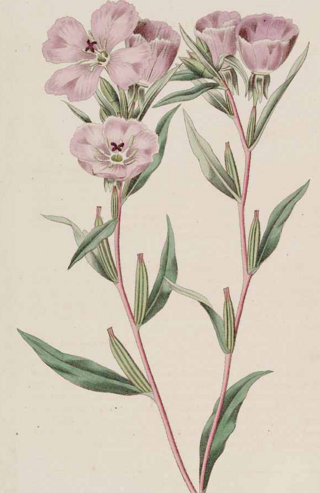
Clarkia purpurea is a species of wildflower known by the common names winecup clarkia, winecup fairyfan, and purple clarkia.

Erysimum menziesii is a species of Erysimum known by the common name Menzies' wallflower.

Clarkia davyi is a species of flowering plant in the evening primrose family known by the common name Davy's fairyfan, or Davy's clarkia. It is endemic to California, where it grows in coastal habitats such as beaches and bluffs. This is an annual herb producing a thin stem which grows along the ground or somewhat upright. It is lined with small oval-shaped leaves one or two centimeters long. While in bud the flower is enclosed in four fused thick sepals. It blooms into a petite bowl-shaped corolla of four pink petals which often have lighter bases. Each petal is 5 to 11 millimeters long.
Clarkia australis is a species of flowering plant in the evening primrose family known by the common name Small's southern clarkia. It is endemic to California, where it grows in the forests of the central Sierra Nevada. It is an uncommon species threatened by such forest activities as logging. This annual herb produces a slender, erect stem approaching a meter in height. The leaves are widely linear in shape and borne on short petioles. The top of the stem is occupied by the tall inflorescence, which bears hanging buds that open from the lowest upward so that there are several closed buds above open flowers. The sepals do not remain fused as the flower opens. The petals are diamond-shaped and sometimes lobed and curling at the tip. They are mottled or spotted lavender, purple, and reddish in color, and each is up to 1.5 centimeters long. There are 8 long stamens tipped with large anthers bearing blue-gray pollen. The stigma protrudes past the anthers.
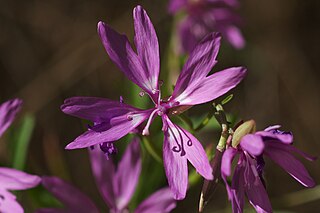
Clarkia biloba is a species of flowering plant in the evening primrose family known by the common name twolobe clarkia and two lobed clarkia.
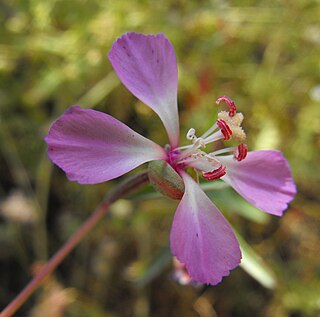
Clarkia delicata is a rare species of flowering plant in the evening primrose family known by the common names Campo clarkia and delicate clarkia. It is native to northern Baja California and adjacent San Diego County, California, where it grows in the woodland and chaparral of the Peninsular Ranges. This is an annual herb producing an erect stem just over half a meter in maximum height. The leaves are oval or widely lance-shaped, up to 4 centimeters long, and borne on very short petioles. The top of the stem is occupied by the inflorescence, in which the lower flowers open while the upper buds hang closed. The sepals remain fused as the flower blooms from one side. Each unlobed oval petal is about a centimeter long and pink to pinkish-lavender. There are 8 stamens, some with large orange anthers and some with smaller, paler anthers. There is also a protruding stigma with four large, fuzzy lobes.

Clarkia epilobioides is a species of flowering plant in the evening primrose family known by the common name canyon clarkia. It is native to California, Arizona, and Baja California, where it grows in shaded habitat in woodland and chaparral. It is an annual herb producing a slender, erect stem sometimes exceeding half a meter in height. The leaves are narrowly to widely lance-shaped and less than 3 centimeters long. The top of the stem is occupied by the inflorescence. Each hanging bud has four red sepals which remain fused all together or in pairs as the petals emerge during blooming. The petals are one half to one centimeter long, oval in shape, solid white or cream in color, often fading pink as they age. There are eight protruding stamens and one stigma.
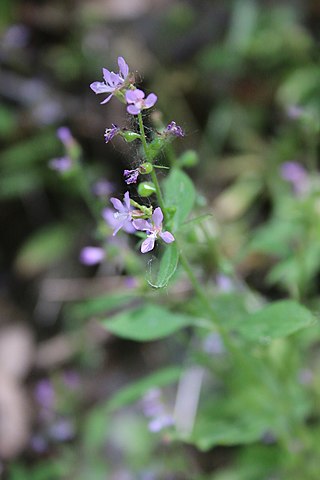
Clarkia heterandra is a species of flowering plant in the family Onagraceae known by the common name mountain clarkia. It is endemic to California, where it is from the forests and woodlands of several of eastern and western mountain ranges. It is an annual herb producing an erect, glandular stem to around half a meter in maximum height. The lance-shaped to oval leaves are up to 8 centimeters long and are borne on petioles of up to 2 centimeters. The top of the stem is occupied by the inflorescence, with open flowers and closed buds. The sepals remain fused as the flower blooms from one side. The pink petals are oval in shape and just a few millimeters long. There are 8 stamens, some large and some small and sterile. The fruit is a small, hard body 2 or 3 millimeters long containing 1 or 2 seeds.
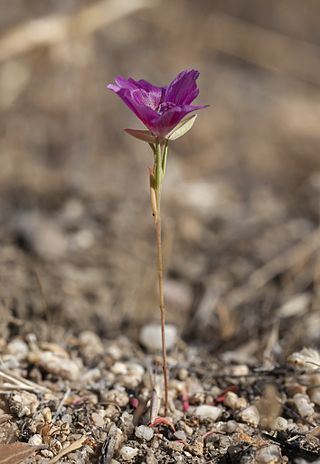
Clarkia jolonensis is an uncommon species of flowering plant in the evening primrose family known by the common name Jolon clarkia. It is endemic to Monterey County, California, where it is known from the woodlands of the Central Coast Ranges.

Clarkia mildrediae is an uncommon species of flowering plant in the evening primrose family known by the common name Mildred's clarkia. It is endemic to California, where it is known from the forests of the southernmost Cascade Range and northern Sierra Nevada. It is an erect annual herb often exceeding half a meter in height. The oval leaves grow up to 6 centimeters long and are borne on petioles of up to 4 centimeters. The inflorescence bears opening flowers and hanging, pointed flower buds. As the bud opens the sepals all separate instead of remaining fused as those of many other Clarkia species do. The triangular to semicircular petals are about 2 centimeters long and lavender to bright reddish-purple, sometimes with dark speckling. There are 8 stamens with anthers all alike, and a protruding stigma.
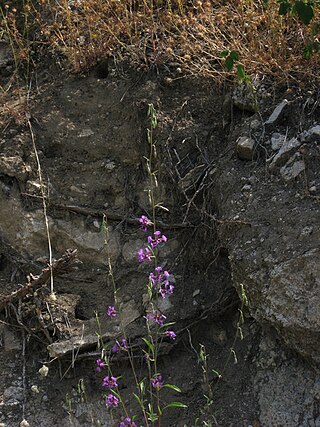
Clarkia mosquinii is a rare species of flowering plant in the evening primrose family known by the common name Mosquin's clarkia. It is endemic to California, where it is known only from the northern Sierra Nevada foothills at the border between Butte and Plumas Counties. It was thought to be extinct until it was rediscovered in 1991. It is an erect annual herb often exceeding half a meter in height. The oval or lance-shaped leaves are 2 to 5 centimeters long. The inflorescence bears opening flowers below a series of clusters of closed, hanging flower buds. The sepals all separate as the flower blooms. The diamond-shaped petals are one to two centimeters long light to medium purple in color, and sometimes speckled with reddish purple.
Clarkia prostrata is a species of flowering plant in the evening primrose family known by the common name prostrate clarkia. It is endemic to the coastline of San Luis Obispo County, California, where it grows on seaside bluffs in forested and grassy areas. This annual herb is prostrate as opposed to erect as most other Clarkia species are. Its stems extend to a maximum length approaching half a meter and are usually somewhat fuzzy in texture. The leaves are oval in shape, up to 2.5 centimeters long, and lack petioles. The sepals of the flower separate into two pairs, revealing the lavender-pink blooming petals. Each petal is just over a centimeter long, fan-shaped to oval, and sometimes with a yellow base marked with a red spot.
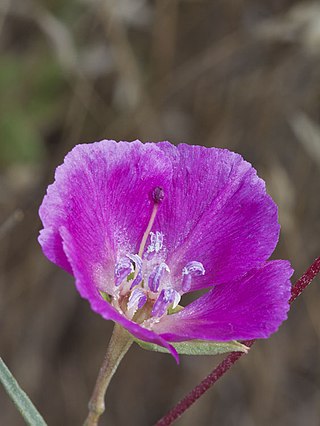
Clarkia speciosa is a species of flowering plant in the evening primrose family known by the common name redspot clarkia. It is endemic to California, where it is known from the Central Coast and mountains and from the Sierra Nevada foothills. The plant is variable across its intergrading subspecies, taking a decumbent to erect form with a stem up to about half a meter long. The open or dense inflorescence has opening flowers and several closed buds. As the bud opens the sepals all separate from each other. The fan-shaped petals are up to 2.5 centimeters long and may be lavender to pink to deep red, sometimes fading to white or yellowish at the base. There is sometimes, but not always, a large bright red spot near the middle of the petal.
Clarkia tembloriensis is a rare species of flowering plant in the evening primrose family, known by the common name Temblor Range clarkia and belonging to the Onagraceae family.

Clarkia virgata is a species of flowering plant in the evening primrose family known by the common name Sierra clarkia. It is endemic to California, where it is known from the forests and woodlands of the Sierra Nevada.

Sidalcea hickmanii is a species of flowering plant in the mallow family known generally by the common name chaparral checkerbloom.

Smilax jamesii is a species of flowering plant in the greenbriar family known by the common name English Peak greenbriar. It is to northern California, where it is known from the Klamath Mountains and the southernmost peaks of the Cascade Range. It has also been reported from nearby locations in southwestern Oregon. It grows in moist areas such as lakesides and streambanks in mountain coniferous forest habitat. It was discovered to be a new species when herbarium specimens thought to be Smilax californica were reexamined.

Streptanthus albidus is a species of flowering plant in the mustard family known by the common name Metcalf Canyon jewelflower. It is endemic to California, where it is known only from the Central Coast Ranges and San Francisco Bay Area. It grows in open areas such as grasslands, often on serpentine soils.
















